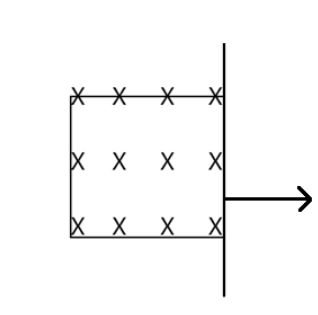
A square loop of area \[2.5 \times {10^{ - 3}}{m^2}\] and having 100 turns with a total resistance of 100 \[\Omega \] is moved out of a uniform magnetic field of \[0.04T\] in 1 s with a constant speed. Then the work done in pulling the loop is:

(A) 0
(B) 1 mJ
(C) \[1\mu J\]
(D) \[0.1mJ\]
Answer
216k+ views
Hint: The work done in pulling the loop is the work done against the emf induced in the loop. It would be equal in magnitude to the electrical work done in the conductor.
Formula used: In this solution we will be using the following formulae;
\[e = NBlv\] where \[e\] is the electromotive force or emf induced in a conductor moving in a magnetic field, \[N\] is the number of turns of the conductor \[l\] is the length of the conductor parallel to the direction of the velocity, and \[v\] is the velocity.
\[W = \dfrac{{{e^2}}}{R}\] where \[W\] is the electrical work done in a conductor and \[R\] is the resistance of the conductor.
\[A = {l^2}\] where \[A\] is the area of the square loop, and \[l\] is the length of the side.
Complete Step-by-Step solution:
To calculate the work done in pulling the loop, we recall that the emf induced in the conductor which is moving in a magnetic field can be given by
\[e = NBlv\] where \[N\] is the number of turns of the conductor\[l\] is the length of the conductor parallel to the direction of the velocity, and \[v\] is the velocity.
Now, we must calculate the length of the sides and the velocity of the movement.
Area of a square is
\[A = {l^2}\] hence, from calculating the length from given area, we have
\[l = \sqrt {2.5 \times {{10}^{ - 3}}} = 0.05m\]
Hence, to calculate \[v\], we have
\[v = \dfrac{l}{t} = \dfrac{{0.05}}{1} = 0.05m{s^{ - 1}}\]
Hence, to calculate the emf,
\[e = NBlv = 100 \times 0.4 \times 0.05 \times 0.05\]
\[ \Rightarrow e = 0.1{\text{V}}\]
Then, the work done is given
\[W = \dfrac{{{e^2}}}{R} = \dfrac{{{{0.1}^2}}}{{100}}\]
\[ \Rightarrow W = 1 \times {10^{ - 4}}{\text{J or 0}}{\text{.1mJ}}\]
Hence, the correct option is D
Note: For clarity, the work done by the emf will actually be in the opposite direction as the work done by object. The moment the conductor starts to move the emf induced will tend to move the object in the opposite direction.
Formula used: In this solution we will be using the following formulae;
\[e = NBlv\] where \[e\] is the electromotive force or emf induced in a conductor moving in a magnetic field, \[N\] is the number of turns of the conductor \[l\] is the length of the conductor parallel to the direction of the velocity, and \[v\] is the velocity.
\[W = \dfrac{{{e^2}}}{R}\] where \[W\] is the electrical work done in a conductor and \[R\] is the resistance of the conductor.
\[A = {l^2}\] where \[A\] is the area of the square loop, and \[l\] is the length of the side.
Complete Step-by-Step solution:
To calculate the work done in pulling the loop, we recall that the emf induced in the conductor which is moving in a magnetic field can be given by
\[e = NBlv\] where \[N\] is the number of turns of the conductor\[l\] is the length of the conductor parallel to the direction of the velocity, and \[v\] is the velocity.
Now, we must calculate the length of the sides and the velocity of the movement.
Area of a square is
\[A = {l^2}\] hence, from calculating the length from given area, we have
\[l = \sqrt {2.5 \times {{10}^{ - 3}}} = 0.05m\]
Hence, to calculate \[v\], we have
\[v = \dfrac{l}{t} = \dfrac{{0.05}}{1} = 0.05m{s^{ - 1}}\]
Hence, to calculate the emf,
\[e = NBlv = 100 \times 0.4 \times 0.05 \times 0.05\]
\[ \Rightarrow e = 0.1{\text{V}}\]
Then, the work done is given
\[W = \dfrac{{{e^2}}}{R} = \dfrac{{{{0.1}^2}}}{{100}}\]
\[ \Rightarrow W = 1 \times {10^{ - 4}}{\text{J or 0}}{\text{.1mJ}}\]
Hence, the correct option is D
Note: For clarity, the work done by the emf will actually be in the opposite direction as the work done by object. The moment the conductor starts to move the emf induced will tend to move the object in the opposite direction.
Recently Updated Pages
Wheatstone Bridge Explained: Working, Formula & Uses

Young’s Double Slit Experiment Derivation Explained

JEE Atomic Structure and Chemical Bonding important Concepts and Tips

JEE Amino Acids and Peptides Important Concepts and Tips for Exam Preparation

Electricity and Magnetism Explained: Key Concepts & Applications

Chemical Properties of Hydrogen - Important Concepts for JEE Exam Preparation

Trending doubts
JEE Main 2026: Application Form Open, Exam Dates, Syllabus, Eligibility & Question Papers

Derivation of Equation of Trajectory Explained for Students

Hybridisation in Chemistry – Concept, Types & Applications

Understanding the Angle of Deviation in a Prism

Understanding Collisions: Types and Examples for Students

How to Convert a Galvanometer into an Ammeter or Voltmeter

Other Pages
JEE Advanced Marks vs Ranks 2025: Understanding Category-wise Qualifying Marks and Previous Year Cut-offs

Ideal and Non-Ideal Solutions Explained for Class 12 Chemistry

Degree of Dissociation: Meaning, Formula, Calculation & Uses

Understanding Electromagnetic Waves and Their Importance

Understanding the Electric Field of a Uniformly Charged Ring

Understanding Average and RMS Value in Electrical Circuits




